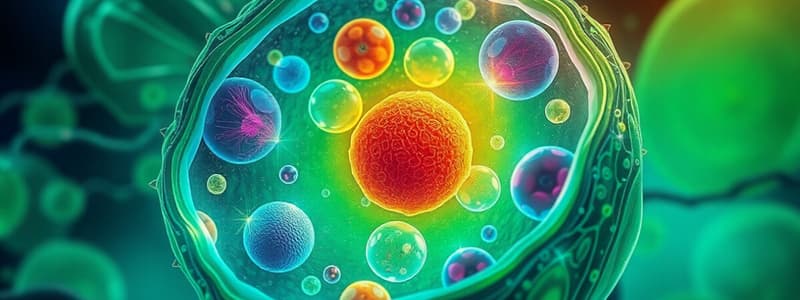Podcast
Questions and Answers
What is the primary function of the central vacuole in a plant cell?
What is the primary function of the central vacuole in a plant cell?
- To synthesize proteins
- To maintain cell pressure against the cell wall (correct)
- To conduct cellular respiration
- To facilitate photosynthesis
Which plant cell structure is responsible for connecting two adjacent plant cells?
Which plant cell structure is responsible for connecting two adjacent plant cells?
- Chloroplast
- Cytoplasm
- Plasmodesmata (correct)
- Cell wall
What is the function of chloroplasts in plant cells?
What is the function of chloroplasts in plant cells?
- To store nutrients
- To produce ribosomes
- To conduct photosynthesis (correct)
- To maintain cell shape
Which part of the plant cell is analogous to the protective layer found in animal cells?
Which part of the plant cell is analogous to the protective layer found in animal cells?
Which of the following structures in a plant cell is involved in protein synthesis?
Which of the following structures in a plant cell is involved in protein synthesis?
Which structure in a plant cell is primarily responsible for maintaining cell shape?
Which structure in a plant cell is primarily responsible for maintaining cell shape?
What is the role of plasmodesmata in plant cells?
What is the role of plasmodesmata in plant cells?
In which plant cell organelle does photosynthesis occur?
In which plant cell organelle does photosynthesis occur?
What is the primary function of the central vacuole in plant cells?
What is the primary function of the central vacuole in plant cells?
Which plant cell structure is involved in the synthesis and modification of proteins?
Which plant cell structure is involved in the synthesis and modification of proteins?
Flashcards are hidden until you start studying
Study Notes
Parts of a Plant Cell
- Plasmodesmata: Serve as communication channels between adjacent plant cells, allowing the exchange of materials and signaling.
- Cell Wall: Composed of cellulose, this rigid structure provides support and defines the shape of the plant cell, protecting it from mechanical stress.
- Plasma Membrane: A semi-permeable barrier that regulates the entry and exit of substances, maintaining homeostasis within the cell.
- Cytoplasm: A jelly-like fluid where cellular processes occur, containing organelles, enzymes, and cytoskeletal elements.
- Central Vacuole: Large membrane-bound organelle filled with cell sap, crucial for turgor pressure, storage of nutrients, and waste products, helping maintain cell rigidity.
- Cytoskeleton: Provides structural support and facilitates movement within the cell, consisting of microtubules, intermediate filaments, and microfilaments, which are involved in transport and cell division.
- Endoplasmic Reticulum (ER):
- Smooth ER: Lacks ribosomes; involved in lipid synthesis and detoxification processes.
- Rough ER: Studded with ribosomes; primarily responsible for protein synthesis and processing.
- Nucleus: Control center of the cell, housing chromatin (DNA), surrounded by a nuclear envelope, and containing the nucleolus, responsible for ribosome production.
- Chloroplast: Contains chlorophyll and is the site of photosynthesis, converting light energy into chemical energy stored in glucose.
- Plastid: A type of organelle that stores various pigments and substances, contributing to the color and function of plant tissues.
- Ribosomes: Sites of protein synthesis, found either freely in the cytoplasm or attached to the rough ER.
- Golgi Apparatus: Functions in modifying, sorting, and packaging proteins and lipids for transport within and outside of the cell.
- Mitochondria: Known as the powerhouse of the cell, they generate ATP through cellular respiration, providing energy for various cellular processes.
- Peroxisome: Contains enzymes that catalyze reactions, including the breakdown of fatty acids and the detoxification of hydrogen peroxide.
Parts of a Plant Cell
- Plasmodesmata: Serve as communication channels between adjacent plant cells, allowing the exchange of materials and signaling.
- Cell Wall: Composed of cellulose, this rigid structure provides support and defines the shape of the plant cell, protecting it from mechanical stress.
- Plasma Membrane: A semi-permeable barrier that regulates the entry and exit of substances, maintaining homeostasis within the cell.
- Cytoplasm: A jelly-like fluid where cellular processes occur, containing organelles, enzymes, and cytoskeletal elements.
- Central Vacuole: Large membrane-bound organelle filled with cell sap, crucial for turgor pressure, storage of nutrients, and waste products, helping maintain cell rigidity.
- Cytoskeleton: Provides structural support and facilitates movement within the cell, consisting of microtubules, intermediate filaments, and microfilaments, which are involved in transport and cell division.
- Endoplasmic Reticulum (ER):
- Smooth ER: Lacks ribosomes; involved in lipid synthesis and detoxification processes.
- Rough ER: Studded with ribosomes; primarily responsible for protein synthesis and processing.
- Nucleus: Control center of the cell, housing chromatin (DNA), surrounded by a nuclear envelope, and containing the nucleolus, responsible for ribosome production.
- Chloroplast: Contains chlorophyll and is the site of photosynthesis, converting light energy into chemical energy stored in glucose.
- Plastid: A type of organelle that stores various pigments and substances, contributing to the color and function of plant tissues.
- Ribosomes: Sites of protein synthesis, found either freely in the cytoplasm or attached to the rough ER.
- Golgi Apparatus: Functions in modifying, sorting, and packaging proteins and lipids for transport within and outside of the cell.
- Mitochondria: Known as the powerhouse of the cell, they generate ATP through cellular respiration, providing energy for various cellular processes.
- Peroxisome: Contains enzymes that catalyze reactions, including the breakdown of fatty acids and the detoxification of hydrogen peroxide.
Studying That Suits You
Use AI to generate personalized quizzes and flashcards to suit your learning preferences.




